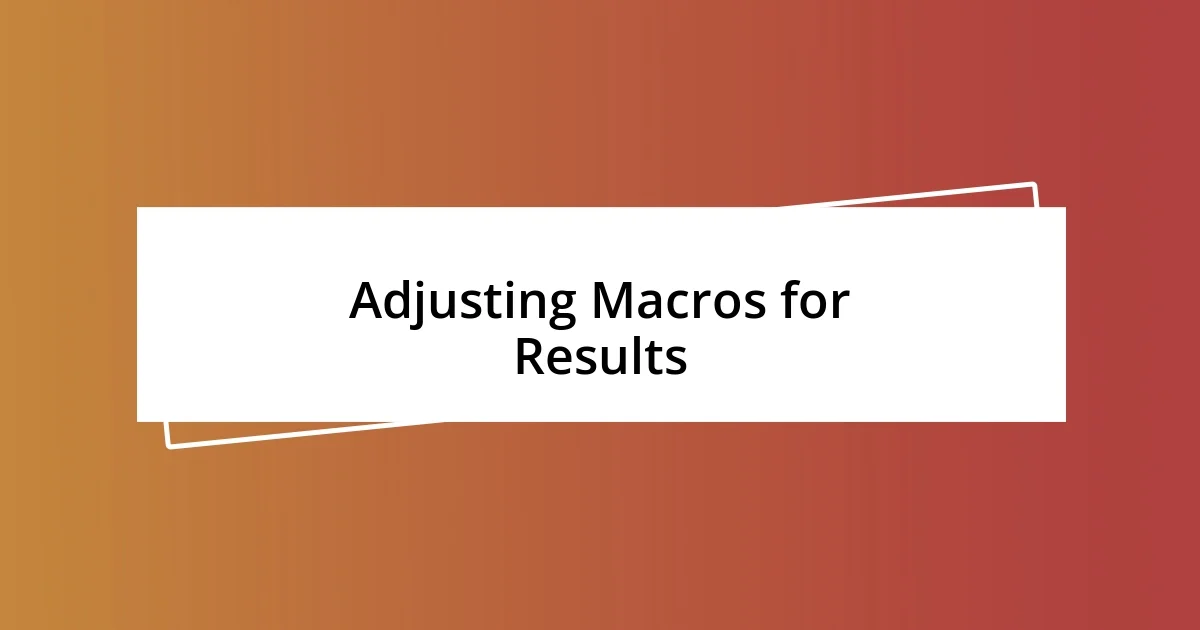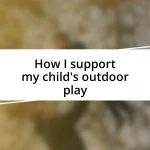Key takeaways:
- Understanding macros (carbohydrates, proteins, fats) is crucial for effective nutrition; each plays a unique role in health and energy.
- Setting SMART goals and using effective tracking tools transformed the author’s approach, making progress measurable and motivating.
- Embracing flexibility, adjusting macros based on personal experiences, and celebrating the process were essential for long-term success in tracking nutrition.

Understanding Macros and Nutrients
When I first delved into the world of nutrition, the idea of tracking macros—essentially macronutrients—felt daunting. Macros encompass carbohydrates, proteins, and fats, and understanding them is key to any nutritional strategy. I vividly remember sitting at my kitchen table, overwhelmed by all the conflicting information out there, and wondering, “How can something so simple be so complicated?”
As I learned more, I realized that each macronutrient plays a unique role in our bodies. For example, proteins are essential for muscle repair and growth, while carbohydrates serve as our primary energy source. It was like a lightbulb moment for me: my meals transformed into a symphony of nutrients rather than just a collection of foods. Have you ever thought about how your favorite meal fits into this framework? I found it fascinating to break down my meals and see how I could fuel my body effectively.
Let’s not forget about fats—often misunderstood, yet vital for hormone production and overall health. I recall grappling with the fear of consuming fats because I mistakenly believed they would sabotage my fitness goals. Once I embraced healthy fats, I felt more satisfied and energized. This realization made me appreciate the balance rather than the deprivation that tracking macros encouraged.

Setting Clear Health Goals
Setting clear health goals is an essential step on any nutritional journey. I remember when I first started, my goals were vague and unrealistic. It felt like wandering around without a map—no defined destination led to frustration and ultimately a lack of progress. Once I began setting specific, measurable, achievable, relevant, and time-bound (SMART) goals, everything changed.
For example, instead of saying, “I want to eat healthier,” I committed to tracking my daily protein intake to ensure I was fueling my workouts properly. I decided to aim for 120 grams of protein a day, which seemed challenging at first. However, breaking that down into smaller meals and snacks made it not only achievable but also surprisingly satisfying. I realized that having clear targets kept me focused and motivated. Do you remember the last time you set a health goal? Think about how it felt to monitor your progress.
Moreover, writing down my goals and reviewing them weekly became a game-changer. I often felt a rush of excitement when I could check off each milestone, no matter how small. It was like celebrating little victories along the way. Tracking these goals helped me form a deeper connection with my health journey, and the accountability kept me on track even during challenging days.
| Goal Type | Description |
|---|---|
| Specific | Clearly define what you want to achieve |
| Measurable | Establish criteria to track progress |
| Achievable | Create realistic and attainable goals |
| Relevant | Ensure the goal matters to you personally |
| Time-bound | Set a deadline to keep you accountable |

Choosing the Right Tracking Tools
Choosing the right tools for tracking macros can really make a difference in your journey. During my early days of tracking, I experimented with various apps and methods until I stumbled upon the ones that truly resonated with me. I remember downloading several apps, finding myself lost in complicated interfaces that felt more like a chore than an aid. Eventually, I discovered user-friendly options that allowed me to effortlessly log my meals. I think about how the right tool turned what felt like a burden into an engaging and enlightening experience.
Here are some key factors I considered when selecting my tracking tools:
- User Interface: I leaned towards apps that were intuitive and visually appealing. A clean layout makes tracking feel less daunting.
- Food Database: I favored tools with extensive food databases, as it saves time and reduces frustration when I want to log meals.
- Customization Options: I found that having customizable settings allowed me to track specific goals, such as adjusting macronutrient ratios or adding personal foods easily.
- Community Support: Engaging with others who use the same tools boosted my motivation. Some platforms offered forums where users shared tips and successes.
- Integration with Wearables: If you live an active lifestyle like I do, tracking apps that sync with fitness devices can provide a comprehensive view of your health.
Reflecting on the tools I chose, it’s clear they played a pivotal role in my macro-tracking journey, turning data into insights and helping me feel in control of my nutritional choices.

Meal Planning for Macro Balance
Meal planning for macro balance became my secret weapon on this journey. I began by dedicating Sundays to map out my meals for the week. There’s something about breaking down the week ahead that not only eased my stress but also helped me visualize how I could hit my macro targets. I remember creating a simple chart where I would jot down my meals alongside their macro values, and it felt like I was crafting a fun puzzle, ensuring every piece fit just right.
I’ve noticed that variety is key to staying motivated, so I always aim to include different proteins, veggies, and healthy fats in my meal prep. One of my go-to meals became a colorful quinoa bowl packed with chickpeas, avocado, and roasted vegetables. Not only did it check off my macronutrient requirements, but the vibrant colors also lifted my spirits every time I opened the fridge. Does anyone else find that how food looks can impact how you feel about eating it?
Furthermore, I learned the importance of leftovers. Preparing larger batches allowed me to have quick meals ready on busy days. When I would come home exhausted, knowing I had a delicious, macro-balanced meal waiting for me was a lifesaver. It taught me that meal planning isn’t just about the food; it’s about setting yourself up for success and making healthy choices seamless. How does it feel when you have a plan in place? For me, it brought a sense of calm amidst the chaos of everyday life.

Monitoring Progress Effectively
Monitoring my progress effectively was a game changer in understanding how my body responded to different macros. I remember vividly the moment I logged my first few weeks of macro intake, and it felt like having a detailed roadmap. Seeing the patterns emerge guided my adjustments, making me more accountable and in tune with my nutritional habits. Have you ever looked back and realized how much your choices have influenced your journey?
As I progressed, I found that tracking not just my food, but also my energy levels and workouts, painted a fuller picture of my health. For example, I had days when I increased my carbs and felt a significant lift in my workouts. This was enlightening; learning to connect the dots between my food and fitness was empowering. I often wondered how many others might be missing these connections because they weren’t tracking their progress holistically.
It’s also worth noting that I embraced the concept of regular check-ins. I set a weekly date with myself to review my macro logs and assess how I felt physically and emotionally. Some weeks were harder than others, but this self-reflection was crucial. It prompted me to celebrate small victories and adjust my approach when necessary. It’s fascinating how a simple review can spark motivation during challenging times, isn’t it?

Adjusting Macros for Results
Adjusting my macros for results was often a trial-and-error experience that required patience and a bit of self-discovery. I remember one particularly frustrating week where I was diligent about hitting my protein targets, yet I felt sluggish and irritable. It prompted me to reassess my carb intake, and I realized that I had inadvertently cut back too much on them. This adjustment not only lifted my energy levels but also gave me a renewed sense of motivation. Have you ever felt that your body was trying to tell you something, only for you to realize you weren’t listening?
As I delved deeper into modifying my macros, I began experimenting with the timing of my meals. I vividly recall the day I decided to shift some of my carbs to earlier in the day, aligning them with my workouts. The results were almost immediate; I experienced better performance during my sessions and less post-workout fatigue. This taught me that sometimes, it’s not just the numbers that matter, but when you consume them. Have you ever played around with your meal schedule and noticed different results? It’s a fascinating relationship to explore.
Additionally, when I found that my progress had stalled, I learned to adjust not only the macros but their ratios. There were days I felt like a juggler, constantly balancing fats, proteins, and carbs. But when I finally shifted my ratio to include more healthy fats, I noticed a significant improvement in my overall satiety and mood. It’s interesting, isn’t it? How a small tweak can create a ripple effect in your mental and physical well-being. Adjusting macros really became an art form for me, as much as it was a science.

Maintaining Long-Term Success
Long-term success in tracking my macros requires a shift in mindset more than just a numbers game. I recall a time when I strived for perfection; every macro was precisely calculated, and I often felt frustrated. It dawned on me that embracing flexibility was key. Have you ever considered that sometimes it’s the ability to adapt that leads to sustainable habits instead of rigid rules?
Building a support system played a significant role in my journey. I sought community connections through online groups where others shared their triumphs and struggles. Listening to their stories made me feel less alone and provided fresh perspectives on challenges I faced. It’s amazing how sharing experiences can motivate you to stay committed, don’t you think?
Another critical aspect was learning to celebrate not just outcomes, but the process itself, regardless of immediate results. One day, while preparing a meal, I felt content in my choices, relishing the nutritious ingredients laid before me. This shift in focus allowed me to appreciate my journey holistically and not just fixate on my weight or measurements. Have you taken a moment to recognize your efforts, outside of the scale? Acknowledging this can bring profound joy and boost your commitment to long-term success.














